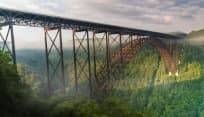6 unique historic districts in West Virginia
The story of West Virginia’s very birth is one for the (history) books! But since our inception in 1863, we’ve built a bunch more stories worth telling.
From booming railroad towns to “Eleanor’s Little Village,” our tiny mountain oases are brimming with history.
1. Stroll into a much swankier past
The storybook town of Bramwell once had the highest number of millionaires per capita in the entire United States. In the late 1800s, a janitor with the Historic Bank of Bramwell (which was rumored to be the richest bank in the country) would push wheelbarrows of leather money bags down the brick paved streets to the train depot, where more than a dozen trains a day would stop. In Bramwell’s heyday, the Bryant Pharmacy (now the Corner Shop) was one of only 3 stores in the nation that sold Chanel No. 5 perfume!
Stroll down the brick-cobbled street known as Millionaire Row, a line of old-time mansions formerly occupied by coal barons. Take in their well-preserved facades, with original ornate woodwork, stained-glass windows and giant porches. Sometimes, homeowners even invite curious passersby in for a closer look.

2. Ride the Amtrak into this historic railroad town
Hinton is another classic boom-and-bust railroad town. This quaint village is enveloped by bright green hills and overlooks the New River. In 1929, the C&O railroad hub boasted 75 retail shops and 21 miles of “first-class” sidewalks. The population had once swelled to nearly 9,000. Today, it’s hovering around 2,500.
Most of the town’s buildings sprung up between 1895 and 1907. Many of them still stand, including the Hinton Marble Works (1895), St. Patrick’s Church (1898) and Hotel McCreery (1907). Hinton’s large historic district is a living museum, a snapshot of the era it was created in.
For railroad lovers, the Amtrak pulls right into town 3 days a week. While you’re there, check out the Hinton Dairy Queen, a local favorite tucked alongside the swift New River and offering unique menu options.
3. “Eleanor’s Little Village”
In 1933, the Roosevelts took to our state to help mountaineers grappling with the Great Depression. In rural Preston County, Eleanor Roosevelt created Arthurdale, the very first New Deal Homestead Community in the country.
165 homes and several community buildings sprung up on 1,100 rolling green acres. These homes gave several West Virginians a second chance. The federal government even provided modern amenities like electricity, indoor plumbing and a refrigerator.
Today, you can still check out a whopping 160 of the 165 original homesteads.

4. Visit a Civil War hotspot
The Harpers Ferry Historic District is a little pocket of big history. Wedged in between the peaceful Potomac and Shenandoah rivers, this district has about 100 historic structures spread between 2 tiny 19th century villages.
Harpers Ferry witnessed the arrival of the first successful American railroad, John Brown’s attack on slavery and the largest surrender of Federal troops during the Civil War.
George Washington named Harpers Ferry the site of the second-ever national armory and arsenal, which was destroyed during the Civil War. But many of the houses built by the U.S. government to accompany the Harpers Ferry Armory still stand today, dotting the mountainside with color.
Don’t forget to take a stoop upon Jefferson Rock, named for none other than Thomas Jefferson. In 1783 he stood in that very spot, writing, “This scene is worth a voyage across the Atlantic.”
5. Visit West Virginia’s smallest incorporated town
At its peak, Thurmond had 2 hotels, 2 banks, restaurants, stores, offices and a movie theater. As many as 95,000 passengers a year were ushered through their train depot. Today, the remains are only a shell of what once was: abandoned buildings, a much quieter pair of train tracks and 5 (yes, 5!) proud residents.
The Great Depression, 2 massive fires and the shift from steam to diesel locomotives all took their toll on the bustling town, once the heart of the New River Gorge. Several of the original structures are still standing, and the pale yellow train depot is now a visitors’ center.
6. Get schooled on civil rights in the capital city
“The Block” in Charleston used to be a thriving epicenter for Kanawha County’s black community. It was a city within a city, with its own houses, laundromats, restaurants, nightclubs, churches and more. Some of the most prominent leaders in African-American history had roots there.
Today the 25-acre area nestled into downtown Charleston still preserves its African American history, with 5 stops on the National Register of Historic Places.
This post was last updated on March 1, 2022







